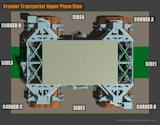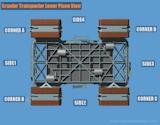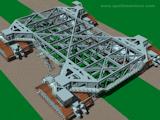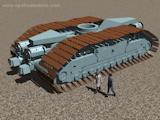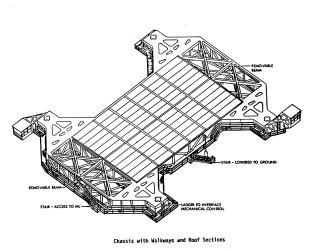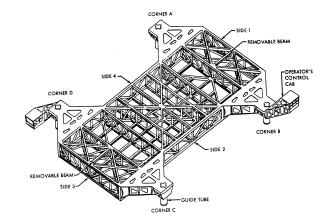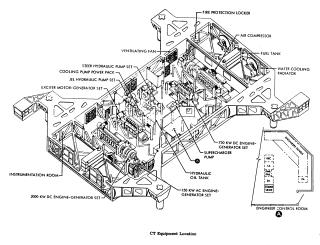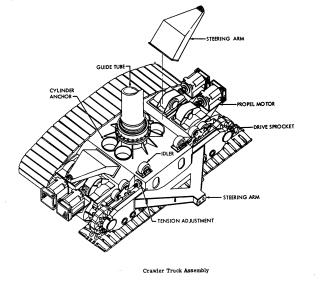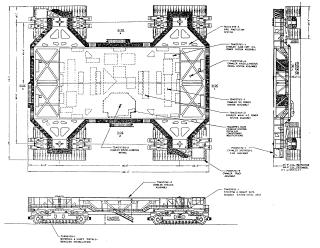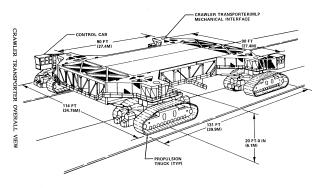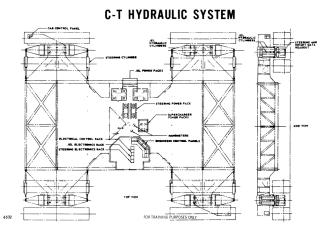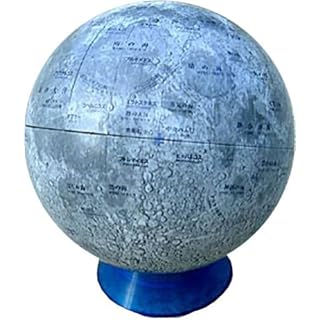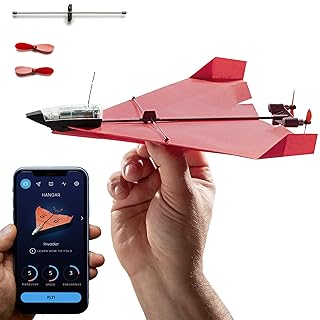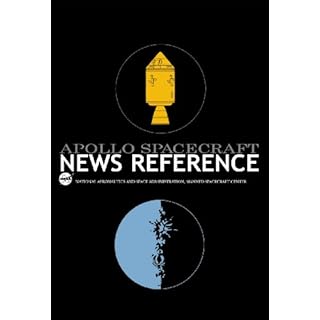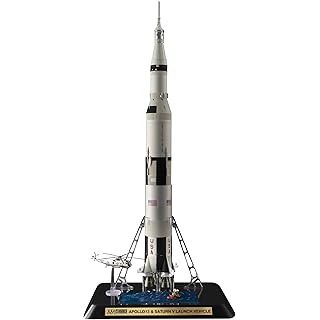NASA Apollo project Crawler Transporter(CT)

- Length : 40 meters(131 ft)
- Width : 35 meters(114 ft)
- Height : 6-8 meter(20-26ft)variable
- Weight : 2,721ton(approx. 5.5 million pound)
- Maximum speed : loaded 1.6km/h(1.0mph) / unloaded 3.2km/h(2.0mph)
- Fuel consumption : 568 liter(150 gallons)/mile (2.8 meter/liter)
- Manufacturer : Marion Power Shovel Co. of Ohio.
- Price : approx. 14 million US dollars
- Consignation : 1st, Nov. 1964
Overview

Fundamental designe was fixed at 1962, the first Crawler arrived on Merritt Island by 1 November 1964. Finally two Crawler Transporters(CT) were delivered to NASA. One was called Hans, and the other was called Franz. It has the three stories building high, and eight lane highway width. The roof of it is flat, and the dimensions of it equals to baseball infield. After the Apollo project, some modification were added for carrying Space Shuttle. These Crawler Transporters are used for about 40 years without major modification.
When they were built, those were the world largest tracked vehicles ever made. (now surpassed by Bagger 288 German excavator(Google search))

Operation
First the Crawler carries the Mobile Launcher(ML) to the VAB(Vehicle Assembly Building). After the Saturn V launch vehicle was built on the ML, the Crawler carries the ML whth the rocket to LC-39 Launch pad. The ML was set on the pad stand faithfully by using Laser guidance system on the Crawler. Next the Crawler carries the Mobile Service Structure(MSS) to the pad for maintain the rocket. Just before the launch, the Crawler carries the MSS to it's parking area. And after the launch, the Crawler carries the ML to maintainance area near VAB.
It takes five to eight hours to carry the ML from VAB to LC-39 launch pad with 11 crews. Distance from VAB to Pad A is approx. 3.5 miles, and to Pad B is approx. 4 miles.
The body of the Crawler can slant plus-minus 10 arcminute to keep the rocket horizontally during climbing the 5% slope of the pad.

Structure
Two operator's control cab are set on backward and forward. All systems are able to controll from this cab. The body of the Crawler is on the four cleats. Each cleats has two tracks of caterpillar and it's size is 3 meters(10 ft) high, 12 meters(41 ft) length. Each caterpillar track consisted of 57 shoes. Each shoe's weight is 907kg. Four 1,000kw generator are driven by two 2,750hp 16 cylinders diesel engines. It's electric power are provided to 16 of 375hp D.C. traction motor.
A.C. power for posture control(jack), steering, ventilation, lighting are provided by two 750 kw generator driven by two 1,065 hp diesel engines. Using this power, four hydraulic pumps drives steering system, and eight hydraulic pumps drives JEL(Jacking, Equalizing, Leveling) system.
In addition, the Crawler carries two 150 kw generators for serving power to Saturn V Mobile Launcher(ML) (or Mobile Launch Platforms(MLP) of SpaceShuttle). The capacity of fuel tank is 5,000 gallons.

Price
At first, Marion Power Shovel Co. offered 8 million US dollars cost to NASA. But Marion finally completed the contract two years later, the price had risen above 14 million dollars. Because of their importance and cost, they were nicknamed, "Them Golden Slippers."
Crawler Transporter scale models

Related Links
Related books and videos
-
1961 to the 21st Century: Launch Complex 39 Then and Now - KSC Apollo and Shuttle Facilities

Progressive Management February 15, 2001 USD28.59
Since Apollo planners first began designing Florida's Launch Complex 39 at the dawn of the space race, this facility has been central to the historic feats of our age. In this World Spaceflight News Special Report, we provide technical details of the Apollo/Saturn V and Shuttle facilities, drawn from rare NASA documents - giving readers the best description available anywhere! A KSC document, "Apollo/Saturn V Facility Description, Launch Complex 39," describes the fantastic parts of America's Moonport: the Vehicle Assembly Building (VAB), Launch Control Center (LCC), Launch Umbilical Tower (LUT),




